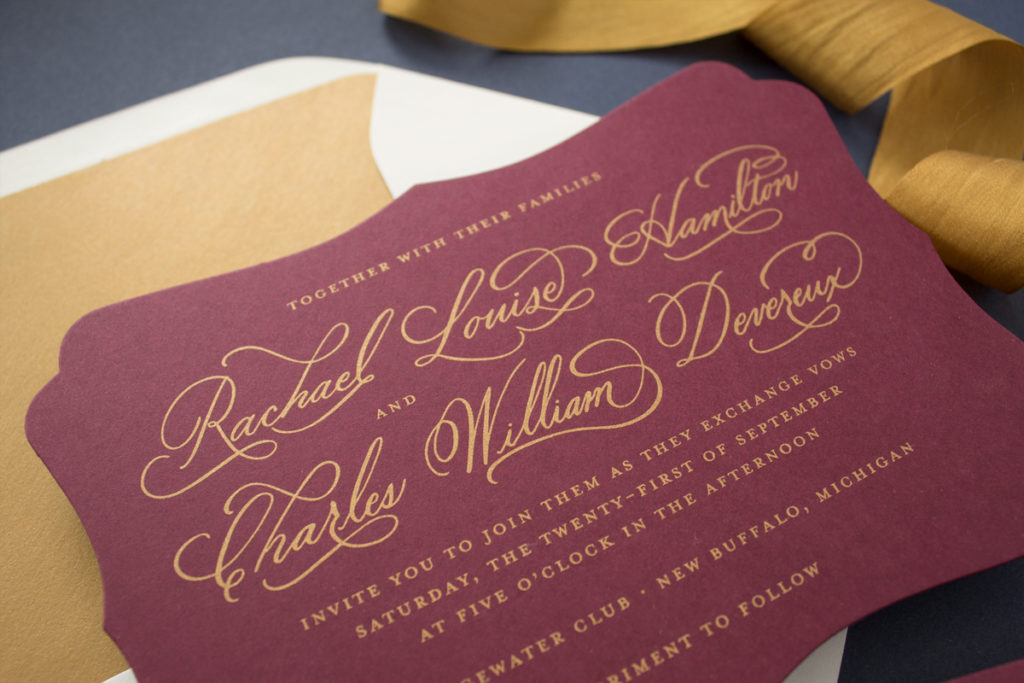So you’ve read all the books on wedding stationery etiquette, nailed down your invitation wording, and the guest list has (finally!!) been approved by both sets of parents. Your wedding planning timeline says it’s time to order invitations, so you get in touch with favorite stationery design, confident that you have all the information you need to begin. But then the stationer starts asks “what printing process are you interested in?” and you realize you have no idea.
If that sounds like you, you’re in the right place! No need to panic, I’ve got the answers to your wedding stationery printing questions in this portion of The Wedding Stationery Guide.
Chances are you’ve never had to worry about things like printing processes before. And that’s absolutely normal! When I was planning my own wedding, I had no idea there were so many different options (let alone what each technique entailed). That’s why I’ve put together this primer on printing processes: so you can make an informed decision when it comes time to choose. (or at the very least, understand what your stationery designer is referring to when they say “One Color”.
While there are a variety of printing processes available, I’m going to focus on the four options I offer here at Banter & Charm: Flat printing, screen printing, letterpress printing, and foil stamping. Have something else in mind? (Like engraving, thermography, or offset) Let me know! I’m eager to try new things, and I have a little black book filled with extremely talented printers I’m dying to work with.
Today I’m giving an overview of the printing processes, but I’ll be covering each one in depth in the coming weeks.
FLAT PRINTING
With flat printing (also known as digital printing) ink is transferred to paper by a digital printing press. The ink lays down flat on the paper leaving a smooth finish. The resulting wedding invitation can feature an unlimited number of ink colors, making it the perfect choice to reproduce multi-color designs like watercolor illustrations. Flat printing is ideal for items with variable text, like guest addresses or escort cards. It is the most affordable of the printing methods I offer, and also has the fastest turn around time.
The full color photo and bright pink flowers (shown in the save the date below) is a great example of a design that is best suited for flat printing.
SCREEN PRINTING
Screen printing (also called silk screen) is an artisan printing method that involves pulling ink through a fine mesh silk screen onto paper. The ink lays flush with the paper (like flat printing), but like letterpress, one ink color is printed at a time.
Screen printing produces metallic inks that shimmer on dark paper, and white screen printing on colored paper is stunning. You can also screen print on other materials like wood veneer or tote bags.
The Cherished design showcases how stunning metallic gold ink looks when screen printed on colored paper.

LETTERPRESS
In letterpress printing, ink is transferred from a raised surface (a printing plate) to paper using the pressure from an antique press, creating impressions in the paper. A custom plate is created for each ink color, then paper is hand fed through a printing press one at a time.
Blind letterpress (also referred to a blind impress or blind deboss) is the technique of letterpress printing with an un-inked plate to press a design into the paper. The result is a subtle texture without color. Because a separate printing plate is made for blind letterpress*, it counts as a “color” for pricing purposes.
1, 2, or 3 color designs with minimal ink coverage work best for letterpress. Most designs are available in letterpress, or can be re-worked to be suitable for letterpress. Letterpress can be paired with foil stamping or flat printing.
The Harmony invitation design shown below features blind letterpress for the lace graphic on the bottom portion of the invite.

FOIL STAMPING
Foil stamping uses a heated die is to press a sheet of thin metallic foil to paper. The resulting design will have a shiny finish – perfect for a brilliant gold or a truly opaque white on dark paper.
Foil stamping works best on minimal designs without delicate lines or large areas of color. Foil pairs beautifully with letterpress or flat printing.
I offer three signature foil colors: gold, silver, copper, and rose gold. However other colors (like white, shiny black, or bright pink) are available for special order.
The Delicate wedding invitation features rose gold foil for the text paired with blind letterpress lace detailing on the edges.

Check back later for a more in depth look at these printing methods, and to find out about the other customization options available at Banter & Charm! You can find all the posts in this series here: The Wedding Stationery Guide



